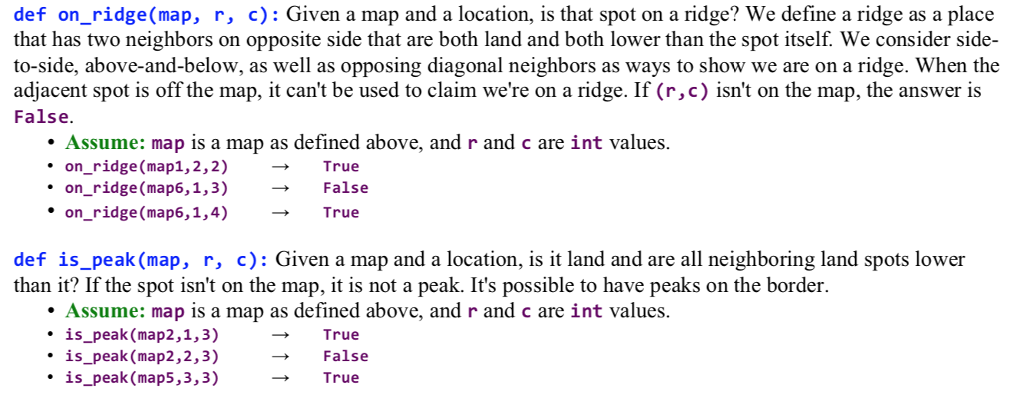Question
Python3, Please help me understand these functions. I have inclued previous functions that might need to be used. Thank you in advance! :) This is
Python3, Please help me understand these functions. I have inclued previous functions that might need to be used. Thank you in advance! :) This is all the functions that i have completed and are part of the project, the only function not completed is join_map_below which i have included as well.
def show(map): #OK mystr = '' substrings = [] maxlen = max([len(str(j)) for i in map for j in i]) for i in map: i = [' '*(int(maxlen)-len(str(j)))+str(j) for j in i] substrings.append(" ".join(i)) return " ".join(substrings) + ' ' def highest_point(map): #OK max = 0 row = 0 column = 0 for i in range(len(map)): for j in range(len(map[i])): if map[i][j] > max: max = map[i][j] row = i column = j if max == 0: return None else: return (row, column)
def on_map(map, r, c): #OK if (r >= 0 and c >= 0 and r = 0): #checking if the length of map is empty or not s = set() for i in range(len(map)): s.add(len(map[i])) for j in map[i]: if not isinstance(j, int): #checking for types return False elif j
def neighbors(map, r, c): #OK neighbors = [] for i in range(r-1, r+2): for j in range(c-1, c+2): if not (i==r and j==c): if i >= 0 and i = 0 and j
def water_adjacent(map, r, c): #OK if r >= 0 and r = 0 and c
def join_map_side(map1, map2): #OK if len(map1) != len(map2): return None else: result = [] for i in range(len(map1)): result.append(map1[i] + map2[i]) return result
def join_map_below(map1, map2): #3/5 failed tests 4,5 if len(map1) != len(map2): return None list = [] for i in map1: list.append(i) for i in map2: list.append(i) return list
def crop(map, r1, c1, r2, c2): #OK if not map: return [] if r1 = len(map): r2 = len(map) -1 if c2 >= len(map[0]): c2 = len(map[0]) -1 if r1 > r2 or c1 > c2: return [] else: result = [] for i in range(r1, r2 + 1): result.append(map[i][c1:c2 + 1]) return result
def flooded_map(map, rise): #OK newmap = [] x = 0 for i in map: newmap.append([]) for j in i: level = j - rise if level rise: map[i][j] = map[i][j] - rise else: map[i][j] = 0
def reorient(map): #OK row = len(map) col = len(map[0]) newmap = [] for i in range(col): newmap.append([]) for j in range(row): newmap[i].append(0) for i in range(row): for j in range(col): newmap[j][i] = map[row - 1 - i][j] return newmap



Step by Step Solution
There are 3 Steps involved in it
Step: 1

Get Instant Access to Expert-Tailored Solutions
See step-by-step solutions with expert insights and AI powered tools for academic success
Step: 2

Step: 3

Ace Your Homework with AI
Get the answers you need in no time with our AI-driven, step-by-step assistance
Get Started


